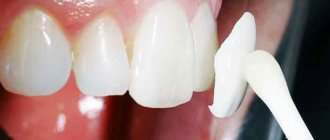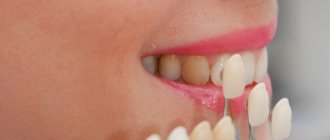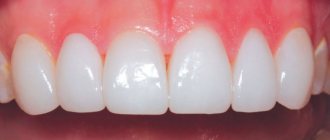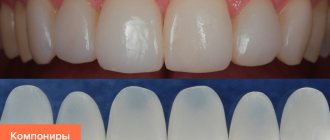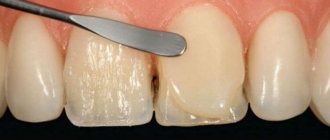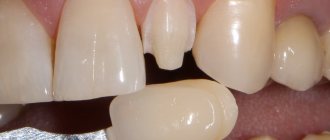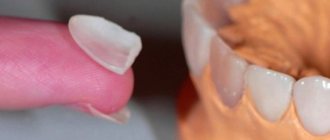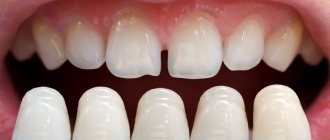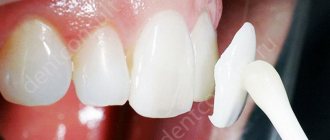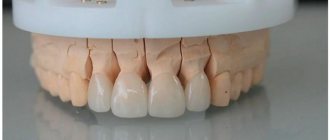Ultraneers, veneers, lumineers - what's the difference?
All these names refer to thin overlays on teeth that allow you to restore the aesthetics of a smile - to hide visible defects such as chips, cracks, interdental gaps or darkening of tooth enamel, and in some cases even straighten teeth.
Veneers
Veneers were the very first to appear on the market. They are made mainly from ceramics, zirconium dioxide or aluminum dioxide. The thickness of such plates is from 0.6 to 1.5 mm. To ensure that veneers do not look too convex and bulky on the teeth, before installing them it is necessary to grind down the natural teeth, which not every patient will agree to.
Lumineers
The appearance of lumineers is the next stage in microprosthetics. They are sometimes called "Hollywood veneers" because they were first used in Hollywood. This is a patented technology, and the onlays themselves are made only in one American laboratory, Cerinate, using a dental impression. The lumineers themselves are very thin - their thickness is up to 0.3 mm, so no preliminary grinding of the teeth is required. Such overlays look more aesthetically pleasing and, as practice shows, last longer (up to 20 years), but they also cost much more than veneers. In addition, they are not suitable for everyone.
Ultraneers
The invention of ultraneers was a successful attempt by Russian specialists to achieve maximum similarity between veneers and lumineers. In other words, ultraneers with a thickness of 0.3 to 0.5 mm are, in a way, analogues of lumineers, but at the same time they are produced in our country. They are made from ultra-strong pressed ceramic IPS e.max, and such designs most often do not require extensive grinding of the teeth.
Indications and contraindications for use
- change in enamel color: yellow or dark teeth, especially in cases where the shade of the enamel cannot be changed with modern whitening methods;
- spaces between teeth (trema or diastema);
- old fillings;
- chips or cracks in enamel;
- protection of weak tooth enamel;
- slight change in the position of the teeth.
Contraindications to the installation of microprostheses are too weak enamel if it requires grinding (without grinding, onlays, on the contrary, protect the teeth from increased sensitivity), serious changes in the bite, teeth that are too long or too short, and severe gum disease. Also, the pads are not suitable for patients with bruxism (if you involuntarily clench your teeth too much, which leads to their grinding, the pads can simply come off due to excessive pressure).
Installation of ultranir in 3 stages
In order to install ultraneers, two visits to the dentist and three technological stages are enough.
Stage 1.
At the first appointment, the doctor will determine the possibility of installing thin ceramic onlays and assess the amount of work. If you have no problems with the health of your teeth and oral cavity, as well as contraindications to the procedure, the specialist will begin making an impression of your dentition.
Stage 2.
Ultraneers will be made for you in the laboratory on the dental impression of the latter within 1 – 2 weeks.
Stage 3.
The second visit to the dental office coincides with the time when the ceramic onlays are ready. First, the doctor will carry out professional teeth cleaning to remove plaque and tartar, preventing the formation of caries under the veneers, and then fix the ultraneers on the outside of the teeth in the smile area using a special composition. Polishing ceramic overlays is the final stage of the procedure.
Installation of ultranir. Just two visits to the dentist
Ultraneers are installed quickly. In order to achieve your goal and get a perfect snow-white smile, just two visits to an orthopedic dentist are enough (usually). At the first visit, the doctor will carefully examine the appearance of the teeth, their relationship, and determine the patient’s bite. All this allows him to verify the possibility of using the chosen method and the absence of contraindications. Next, the doctor will make impressions and determine the color of the patient’s teeth, their level of transparency and select the shade of ultraneers, possibly several shades, this allows them to be made as similar as possible to their own teeth.
The impressions are sent to the laboratory where ultraneers are made individually for each patient.
At the second visit, the dentist fixes the ultraneers with composite glue.
Advantages and disadvantages of ultranir
Installing ultraneers can be beneficial for a number of reasons, but it is worth installing the onlays taking into account the recommendations of your doctor. In the table below, Startsmile compared all the pros and cons of ultranir.
- Installation of ultraneers is quick and painless.
In Russian laboratories, ultraneers are produced in 7–14 days, while the production of lumineers requires additional time (up to 30 days) to ship finished structures from the USA. Installation of ceramic plates does not cause discomfort - the procedure is painless. - Partial restoration available.
If your goal is to improve the appearance of 1-2 teeth, installing ultraneers will be the ideal solution, while the use of lumineers is only relevant when restoring the entire smile area. This is due to the fact that ultraneers are more transparent than lumineers and are closer to the natural color of teeth, although they give them a lighter shade. - You can always remove ultraneers.
The procedure takes little time and does not damage tooth enamel. - Affordable price.
No damage to the enamel if the patient wants to return the teeth to their original state.
- Ceramic linings require careful handling and care.
The downside of ultraneers is that you will have to stop eating solid foods (nuts, crackers, seeds) and eat raw fruits and vegetables with caution. Otherwise, the records may crack. Do not forget about regular brushing of your teeth twice a day, as well as the need to use dental floss and an irrigator, cleaning the gingival folds and the space between the teeth. - Ultraneers do not correct serious dental defects.
If you have severely crooked teeth, large chips, or thinned tooth enamel, applying ceramic onlays will not help the situation. In addition, ultraneers are attached to the teeth in the smile zone, which means they can correct minor defects only in the front teeth. - The procedure may be prohibited.
If you have diseases of the teeth or oral cavity (for example, gingivitis, periodontitis and others), then ultraneers are contraindicated for you.
Make an appointment
right now!
Kolesnichenko Marina Vladimirovna
Orthodontist, Therapist, Periodontist
Advantages of using ultra-veneers
There are several important advantages in favor of choosing this option for teeth correction:
- Manufacturing speed. All ultraneers are created in Russia, which makes it possible to reduce the duration of their production to 7-14 days. This is two to three times less than in the case of lumineers.
- Comfortable installation. The patient will not experience pain during the process. The doctor works quickly and does not cause you discomfort.
- Possibility of partial restoration. You can put ultraneers even on one tooth - they are completely invisible in the oral cavity and look natural.
At the same time, ultraneers are distinguished by a high level of strength and are more affordable than lumineers.
Ultraneers - price in Moscow for 1 tooth
The cost of one ceramic onlay depends on the level of the clinic performing ultraneers and the qualifications of the doctor. On average, for a plate for 1 tooth (each ultraneer is made separately) in Moscow you will have to pay 20 - 25 thousand rubles, and ultraneers will cost you less than lumineers and, as a rule, more expensive than veneers. If the clinic offers you ceramic onlays for much less than 20 thousand rubles, this may indicate low quality of the material or insufficient experience of the specialist.
Publisher: Expert magazine about dentistry Startsmile.ru
Where in Moscow you can install ultranir at a good price
If it is necessary to install ultranirs, you must understand that their advantage lies not only in the relatively low cost of a set of installation services and materials. But the final price may be influenced by factors such as the qualifications of the doctor who performs the installation, the level of equipment in the clinic, the amount of work and the need for additional treatment.
Installing ultranir is a rather complicated process that you should not skimp on, so it is better to entrust the issue to professionals. The experience of Beskudnikovo Dentistry specialists allows us to guarantee high-quality work results and a long service life of the installed prostheses.
Installation of onlays: stages of treatment
Installing onlays on teeth takes from 2-3 days to a month, depending on the type of microprosthesis chosen. In general, the patient will undergo the following treatment:
First visit:
- preparation of teeth: professional cleaning to remove plaque, tartar, treatment of caries or other diseases, if any,
- removing part of the enamel: this step is relevant only when installing veneers or ultraneers,
- taking impressions that will be used to create custom prostheses.
About 2-4 days pass between the first and second visit - this is the time it takes to make the dentures in the laboratory. However, if you choose lumineers, then about a month will pass between the stages, because the designs are developed abroad and sent to the Russian clinic.
Second visit:
- installation of prostheses: after the structures are created in the laboratory, they are tried on and, if necessary, adjusted. The surface of the teeth must be polished and treated with abrasive. Next, glue-cement is applied and the linings are tightly glued to the surface of the teeth.
How is the installation carried out?
In order to install ultraneers at MedicaStom, it is enough to make only 3 visits to the doctor.
1st visit
Taking an impression
30 minutes
2nd visit (after 3 days)
Transferring the wax model into the oral cavity, color selection
60 minutes
3rd visit (after 5-7 days)
Fixing ultranir
Luxurious smile!
90 minutes
Make an appointment or call us right now, and in just 10 days you will be the owner of a dazzling smile! There will be no difficulties with installation.
In what cases are ultraneers installed?
Despite the increased attractiveness of microprostheses for modern residents, they cannot solve complex dental problems. As a rule, ultraneers are installed only if there are minor deficiencies:
- Cosmetic enamel defects (chips and cracks);
- Hereditary or acquired darkening of shade;
- Slight curvature of individual areas;
- The presence of minor gaps between dental units.
Before installing ultraneers in Moscow, a specialist must carry out a thorough inspection and identify possible limitations. These include:
- Malocclusion;
- Unconscious closing of the jaws;
- Excessive tooth wear;
- The presence of any infectious processes in the body, diseases in the cardiovascular system, psychological disorders, etc.);
- Inadequate oral care.
Installation
They are installed in the following sequence:
- During the first session, the dentist makes a double silicone impression of the teeth.
- Selecting the optimal color for your future smile.
- Creation of first wax and then ceramic prostheses in the laboratory.
- During the second visit, the doctor places the fabricated structure on the tooth surface.
- If necessary, additional light adjustments and turning of the plates are carried out.
- After 7 days, the dentist evaluates the quality of the fastening, processes and polishes the teeth.
Service life, care
Ultraneers are unique prostheses that, despite their thinness, can withstand significant loads on the jaw. However, even such a durable material requires careful handling. Their service life directly depends on the quality of installation, regular maintenance of oral hygiene and compliance with medical recommendations. With careful use, dentures will please their owner for at least 15 years.
No special care is required to maintain the original appearance of ultraneers. It is necessary to regularly brush your teeth, use rinses, do not get carried away with toothpicks, visit the dentist in a timely manner and give up bad habits.
Price
On average, prices for ultranir range from 20,000 to 35,000 rubles per piece. The final cost depends on the amount of work and the number of damaged teeth.
Dental care
The most important thing that every patient should remember is that he has dentures installed. And no matter how reliable, strong and durable they are, these are still artificial teeth. Just like living ones, they need special care - regular brushing and toothpaste, and mandatory regular dental checkups. You should not bite off too hard foods with your new teeth - even apples should be cut into small pieces, otherwise the lining may break off. Follow these simple rules and your new teeth will last you for decades.
Ultraneers or “E.max ultra-thin veneers”
Ultraneers are created from German-made E.max ceramics. They are much thinner than veneers, but slightly thicker than lumineers - their thickness is no more than 0.6 mm. Therefore, in some cases, it is possible to do without tooth preparation, or to carry out very minimal grinding.
Pros:
- excellent aesthetics comparable to Lumineers,
- an alternative to lumineers in almost all respects,
- maximum naturalness of the renewed dentition,
- preservation of the color and shape of the dentures,
- more durable ceramics than those used to create veneers, which is why ultraneers are thinner than veneers,
- fast production times for overlays, because they are created in Russia,
- long service life - 10 years or more.
Minuses:
Among the relative disadvantages of ultranir is, again, their cost. They are 30% cheaper than lumineers, but restoring the entire dentition will still cost a pretty penny. In addition, when installing ultraneers, it is often necessary to grind the teeth, albeit minimally.
Expert comment:
Alina Chilingaryan, dental therapist: “Ultraneers are an intermediate option between inexpensive veneers and high-priced lumineers. Their cost is 30% lower than lumineers, that is, about 20 thousand rubles per tooth. At the same time, they can be installed faster, since they are created in Russia. But in some cases you can’t do without turning.”
Ceramic veneers
Ceramic veneers are the thinnest plates made of high quality ceramics. They are fixed on the front surface of the teeth and completely cover it. In this case, all other sides of the teeth, except the front, remain completely intact.
Porcelain veneers are very resistant to abrasion and other damage. Compared to metal-ceramics, they are much less susceptible to chipping. Modern ceramic materials are characterized by high strength and hardness, due to which all the functional abilities of the teeth are fully preserved. In addition, veneers made from ceramics do not lose their original color at all, even if their owner often drinks coffee and tea in large quantities.
Ceramic porcelain veneers can not only significantly transform the appearance of teeth, but also reliably serve for a long time.
The cost of ceramic veneers is 16,000 rubles.
Ultraneers
Ultraneers are an easy way to get a Hollywood smile! Ultraneers can rightfully be called a unique innovative development in the field of modern dentistry. They are the thinnest plates made of special high-quality porcelain and designed for extension onto the outer surface of the teeth. Using ultranir, the thickness of which is no more than 0.3 millimeters, you can correct the shape and color of your teeth.
Ultraneers , which are a more modern and improved analogue of lumineers, are an excellent choice for people who want their teeth to look perfect. One of the most important advantages and disadvantages is that when teeth are straightened with ultraneers, the patient’s teeth do not require absolutely any pre-treatment.
The main indications for installing ultraneers are small chips and cracks in the teeth, trema or diastema - spaces between the teeth, slight curvature of the teeth, abrasion and grinding, as well as the shape and color of the teeth that do not suit the patient.
If you want your teeth to become snow-white and shining, you should not resort to multiple whitening procedures. It is much better to go to the office of a highly qualified dentist who will install ultraneers on your teeth. Just two visits are enough and you will become the owner of a brilliant Hollywood smile! During the first session, the doctor will perform a bite analysis and create impressions of the patient’s teeth. And during the second, he will build up ready-made ultraneers using a solution of special dental cement.
True, there are problems that teeth straightening with Ulranir cannot be solved. These include the presence of large chips on the teeth, as well as very pronounced curvature. In addition, if the teeth are very short, it is impossible to lengthen their crown part using ultraneers. If such serious shortcomings are not observed, ultranir will be the right solution!
Veneers
Historically, the first artificial devices to correct such defects were veneers. Varieties are known. Ceramic veneers or those made on the basis of metal dioxides - aluminum, zirconium - are more often used. The linings are relatively thick, the figure ranges between 0.6 and 1.5 mm. The installation of veneers is considered final; it is impossible to remove them in the future, because before installation the doctor will have to grind down the tooth enamel. Without such a radical measure, the plates will seem unnaturally convex.
Prices for services
Consultation with a dentist - orthopedist Free Installation of 1 ultranir (ultra-thin onlay) from RUB 21,990.Ultraneers are innovative ultra-thin ceramic plates with unprecedented fracture strength! Analogous to Western lumineers. No grinding of teeth (as for veneers) is required!
We produce ultraneers in our dental laboratory. Therefore, our clients can enjoy a snow-white smile with ready-made ultraneers in just 8–10 days. And the cost is 1.5–2 times less. The price will pleasantly surprise even budget-conscious customers.
Advantages and benefits of veneers
One of the main advantages of high-quality dental ceramics that are currently used is its absolute biocompatibility. In addition, these materials are distinguished by high aesthetic properties; like the natural enamel of healthy teeth, they create the effect of optical translucency. Therefore, veneers are the optimal solution in the presence of chips, wide interdental gaps, uneven tooth shapes, as well as changes in the natural color of the teeth. A wide range of colors will allow you to produce veneers of any shade, depending on the wishes and preferences of the patient.
Veneers are also good because they practically do not require any special care - just clean them regularly with a regular toothbrush.
